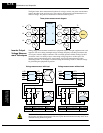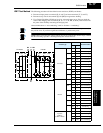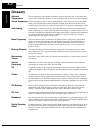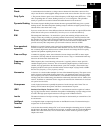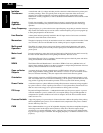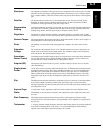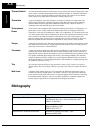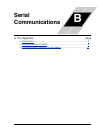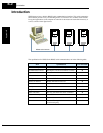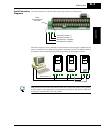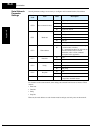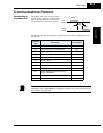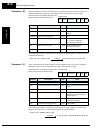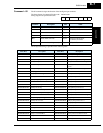
Bibliography
Appendix A
A–6
Thermal Switch An electromechanical safety device that opens to stop current flow when the temperature at the
device reaches a specific temperature threshold. Thermal switches are sometimes installed in
the motor in order to protect the windings from heat damage. The inverter can use thermal
switch signals to trip (shut down) if the motor overheats. See also trip.
Thermistor A type of temperature sensor that changes its resistance according to its temperature. The
sensing range of thermistors and their ruggedness make them ideal for motor overheating
detection. Hitachi inverters have built-in thermistor input circuits, which can detect an
overheated motor and shut OFF (trip) the inverter output.
Three-phase
Power
An AC power source with three Hot connections that have phase offsets of 120 degrees is a 3-
phase power source. Usually, Neutral and Earth Ground wires accompany the three Hot
connections. Loads may be configured in a delta or Y configuration. A Y-connected load such
as an AC induction motor will be a balanced load; the currents in all the Hot connections are the
same. Therefore, the Neutral connection is theoretically zero. This is why inverters that
generate 3-phase power for motors do not generally have a Neutral connection to the motor.
However, the Earth Ground connection is important for safety reasons, and is provided.
Torque A measure of rotational force. The units of measurement are the product of the distance (radius
from shaft center axis) and force (weight) applied at that distance. Units are usually given as
pound-feet, ounce-inches, or Newton-meters.
Transistor A solid state, three-terminal device that provides amplification of signals and can be used for
switching and control. While transistors have a linear operating range, inverters use them as
high-powered switches. Recent developments in power semiconductors have produced transis-
tors capable of handling high voltages and currents, all with high reliability. The saturation
voltage has been decreasing, resulting in less heat dissipation. Hitachi inverters use state-of-
the-art semiconductors to provide high performance and reliability in a compact package. See
also IGBT and saturation voltage.
Trip An event that causes the inverter to stop operation is called a “trip” event (as in tripping a
circuit breaker). The inverter keeps a history log of trip events. They also require an action to
clear.
Watt Loss A measure of the internal power loss of a component, the difference between the power it
consumes and what its output delivers. An inverter’s watt loss is the input power minus the
power delivered to the motor. The watt loss is typically highest when an inverter is delivering
its maximum output. Therefore, watt loss is usually specified for a particular output level.
Inverter watt loss specifications are important when designing enclosures.
Bibliography
Title Author and Publisher
Variable Speed Drive Fundamentals, 2nd Ed. Phipps, Clarence A.
The Fairmont Press, Inc. / Prentice-Hall, Inc. 1997
ISBN 0-13-636390-3
Electronic Variable Speed Drives Brumbach, Michael E.
Delmar Publishers 1997
ISBN 0-8273-6937-9
Hitachi Inverter Technical Guide Book Published by Hitachi, Ltd. Japan 1995
Publication SIG-E002



